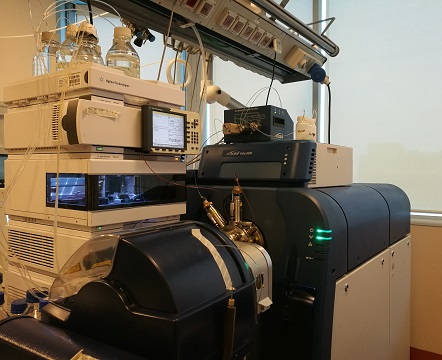
Core facilities
ProMeFa

Mission
The Proteomics and Metabolomics Facility (ProMeFa) provides different analytical approaches aimed at structurally characterizing small molecules, peptides and proteins. The Facility is equipped with state-of-the-art mass spectrometers and has access to the nuclear magnetic resonance (NMR) instrument within the Consorzio 7C (Ronzoni Istitute for Chemical and Biochemical Research, Milan). Mass spectrometry and NMR are crucial techniques, which give a major contribution to the description and understanding of biological processes at the molecular level.
Activities
The goal of the Facility is to assist scientists in their research on a fee-for-service basis, covering all the operating costs, including consumables, time-machine and technical support.
ProMeFa activities can be divided in:
- Mass Spectrometry analysis:
- Protein characterization
- Proteomics
- Metabolomics/Lipidomics
- Nuclear Magnetic Resonance (NMR) analysis
- Protein biochemistry analysis
All the activities comprise appropriate scientific consultancy, interpretation of the results, and a report on the analytical data signed by the facility manager.
Guidelines and detailed protocols for sample preparation are available here.
Request forms for OSR and external users are available here:
Access info
Due to the complexity and cost of some of the equipment, only the staff of the facility has direct access to the machines. Interested people can be trained upon request. Samples are accepted every day.
ProMeFa is located in Dibit 2, San Gabriele 2, C1, 4th floor (mass spectrometry services) and at Dibit 2, Basilica A3, 3rd floor (NMR and protein biochemistry services).
First time users and anyone wanting to submit large numbers of samples at once (more than 15) are urged to contact the Facility prior to sample submission. The sample(s) has to be shipped together with the filled request form/order. ProMeFa strongly suggest contacting the staff of the Facility before filling in any request form, in order to define exactly the activity to be carried out on the samples.
Here you can find some frequently asked questions: FAQs.
Mass Spectrometry analysis
Protein characterization:
Sample purification (zip tip or similar) and intact protein/peptide MW determination by nanospray off line MS and MS/MS.
Proteomics:
-
Identification of a spot or a band by in gel digestion and LC-MS/MS
-
PTM-characterization in several biological fluids (plasma, serum, urine, CSF), cells and conditioned media, tissues, feces:
-
glycosylation by enzymatic digestion followed by LC-MS/MS
-
acetylation by PTMScan enrichment (Cell Signaling Technologies) followed by LC-MS/MS
-
phosphorylation (Tyr/Thr/Ser) by TiO2 or IMAC enrichment followed by LC-MS/MS
-
Quantitative protein profiling by mass spectrometry and statistical analysis. Differential protein display in two or more diverse conditions in several biological fluids (plasma, serum, urine, CSF), cells and conditioned media, tissues, feces, using:
-
iTRAQ or TMT labelling of peptides
-
SILAC methodology
-
Label-free approach
Metabolomics/Lipidomics:
-
Untargeted workflow for differential small molecules/lipids display in several biological fluids (plasma, serum, urine, CSF), cells and conditioned media, tissues, feces.
-
Targeted workflow for specific small molecules/lipids display in several biological fluids (plasma, serum, urine, CSF), cells and conditioned media, tissues, feces.
-
Tracing experiments in cell culture using stable isotope labelled (13C/15N) small molecules (glucose, glutamine, arginine)
Nuclear magnetic resonance (NMR) analysis
-
NMR spectra acquisition (1D 1H spectra for profiling, untargeted and targeted analysis; 2D spectra to assist metabolites identification from tissue/cells for endometabolomic analysis, biofluids, extracellular medium
-
Statistical analysis: Multi- and univariate statistical analysis (minimum 3 samples for group, 2 groups) and pathway analysis for untargeted approach
-
Targeted analysis: Profiling and semi quantification using Chenomx 8.4 and univariate statistical analysis (minimum 3 samples for group, 2 groups)
-
Stable Isotope Resolved Metabolomics (SIRM) for metabolic flux analysis
-
Unknown metabolites identification
Protein biochemistry analysis (available either as service or for a supervised use only for internal laboratories)
-
Protein detection by capillary Western blot: protein immune-detection and semi-quantitative evaluation of protein expression in biological samples.
|
ANALYSIS BY MASS SPECTROMETRY |
INTERNAL/EXTERNAL |
|
Protein Characterization |
|
|
Sample purification (zip tip or similar) and intact protein/peptide MW determination by nanospray off line MS |
75 / 82 € |
|
Sample purification (zip tip or similar) and intact protein/peptide MW determination by nanospray off line MS/MS |
100/110 € |
|
Proteomics |
|
|
Identification of a spot or band by in gel digestion and LC-MS/MS |
200/240 € (the price goes down with the number of bands/spots) |
|
PTM-characterization in several biological fluids (plasma, serum, urine, CSF), cells and conditioned media, tissues, feces:
|
300/350 € |
|
Prices are tailored to each project; *300/350 € per single protein |
|
|
Quantitative protein profiling by mass spectrometry and statistical analysis. Differential protein display in two or more diverse conditions in several biological fluids (plasma, serum, urine, CSF), cells and conditioned media, tissues, feces, using: |
|
|
iTRAQ* or TMT* labelling of peptides (run in technical duplicate) |
2500/3000 € |
|
SILAC methodology* (run in technical duplicate) |
2500/3000 € |
|
Label-free approach (run in technical triplicate) |
800/960 € |
|
*iTRAQ or TMT-reagents or labelled amino acids are in charge to the customers |
|
|
Metabolomics/Lipidomics |
|
Prices are tailored to each project |
|
|
Data analysis |
60/80 € per hour |
|
METABOLOMICS ANALYSIS BY NMR |
INTERNAL/EXTERNAL |
|
NMR experiment 1D 1H or 2D NMR experiments (tissue/cells) |
37/45 € per sample |
|
NMR experiment 1D 1H or 2D NMR experiments (biofluids) |
30/38 € per sample |
|
Multivariate statistical analysis |
60/80 € per hour |
|
Targeted analysis and semi quantification using Chenomx 8.4 |
30/50 € per sample |
|
Data analysis (pathways analysis) |
60/80 € per hour |
|
Unknown metabolites identification |
Price is tailored after discussion |
|
Stable Isotope Resolved Metabolomics (SIRM) (fluxomics) |
Price is tailored after discussion |
|
PROTEIN BIOCHEMISTRY ANALYSIS |
|
|
|
Protein detection by capillary Western blot (For the fees, please contact Dr. Mannella: mannella.valeria@hsr.it) |
||
|
Protein immune-detection – 1 cartridge 13 samples |
|
|
|
Protein immune-detection – 1 cartridge 13 samples |
|
|
|
Semi-quantitative evaluation of protein expression – 1 cartridge 13 samples |
|
|
|
Semi-quantitative evaluation of protein expression – 1 cartridge 25 samples |
|
|
|
Data analysis with Compass® software |
|
|
MASS SPECTROMETRY ANALYSIS
ACTIVITIES |
PROCESSING TIME |
| Protein characterization: | |
| Sample purification (zip tip or similar) and intact protein MW determination by MALDI or nanospray off line MS or MS/MS | 3 days |
| Proteomics: | |
| Identification of a spot or a band by in gel digestion and LC-MS/MS | 1 week per single protein |
PROCESSING TIMING DEPENDS ON THE NUMBER OF SAMPLES FOR:
Proteomics:
-
PTM-characterization in several biological fluids (plasma, serum, urine, CSF), cells and conditioned media, tissues, feces:
-
glycosylation by enzymatic digestion followed by LC-MS/MS
-
acetylation by PTMScan enrichment (Cell Signaling Technologies) followed by LC-MS/MS phosphorylation (Tyr/Thr/Ser) by TiO2 or IMAC enrichment followed by LC-MS/MS
-
-
Quantitative protein profiling by mass spectrometry and statistical analysis. Differential protein display in two or more diverse conditions in several biological fluids (plasma, serum, urine, CSF), cells and conditioned media, tissues, feces, using:
-
iTRAQ or TMT labelling of peptides
-
SILAC methodology
-
Label-free approach
-
| Metabolomics/Lipidomics: | |
|
NMR METABOLOMICS ANALYSIS
ACTIVITIES |
PROCESSING TIME |
| Untargeted analysis (samples preparation, experiments acquisition and multivariate analysis) | 4-6 weeks |
| Targeted analysis (sample preparation, experiments acquisition, identification of metabolites by chenomx and 2D NMR experiments, statistical analysis) | 4-6 weeks |
Processing time depends on the number of samples and type of analysis.
PROTEIN BIOCHEMISTRY ANALYSIS
ACTIVITIES |
PROCESSING TIME |
| Protein detection by capillary Western blot |
|
|
3 days |
|
3 days |
|
1 week |
Output of the results will be sent in an Excel or Word format, along with information on: mass spectrometer settings, protein database version, search parameters.In case of maintenance or out of order instrumentation as well as when multiple samples are submitted, the processing time can be longer.
When the Facility will send the results of the analysis (by fax or e-mail) then the Grant Office will give the invoice to the user for the payment.
Anderluzzi G, Ghitti M, Gasparri AM, Taiè G, Sacchi A, Gori A, Andolfo A, Pozzi F, Musco G, Curnis F, Corti A. A novel aminopeptidase N/CD13 inhibitor selectively targets an endothelial form of CD13 after coupling to proteins. Cell Mol Life Sci. 2024 Jan 30;81(1):68. doi: 10.1007/s00018-023-05102-1.
Caronni N, La Terza F, Vittoria FM, Barbiera G, Mezzanzanica L, Cuzzola V, Barresi S, Pellegatta M, Canevazzi P, Dunsmore G, Leonardi C, Montaldo E, Lusito E, Dugnani E, Citro A, Ng MSF, Schiavo Lena M, Drago D, Andolfo A, Brugiapaglia S, Scagliotti A, Mortellaro A, Corbo V, Liu Z, Mondino A, Dellabona P, Piemonti L, Taveggia C, Doglioni C, Cappello P, Novelli F, Iannacone M, Ng LG, Ginhoux F, Crippa S, Falconi M, Bonini C, Naldini L, Genua M, Ostuni R. IL-1β+ macrophages fuel pathogenic inflammation in pancreatic cancer. Nature. 2023 Nov;623(7986):415-422. doi: 10.1038/s41586-023-06685-2. Epub 2023 Nov 1.
Runfola V, Giambruno R, Caronni C, Pannese M, Andolfo A, Gabellini D. MATR3 is an endogenous inhibitor of DUX4 in FSHD muscular dystrophy. Cell Rep. 2023 Sep 26;42(9):113120. doi: 10.1016/j.celrep.2023.113120.
Lazzarato L, Bianchi L, Andolfo A, Granata A, Lombardi M, Sinelli M, Rolando B, Carini M, Corsini A, Fruttero R, Arnaboldi L. Proteomics Studies Suggest That Nitric Oxide Donor Furoxans Inhibit In Vitro Vascular Smooth Muscle Cell Proliferation by Nitric Oxide-Independent Mechanisms. Molecules. 2023 Jul 28;28(15):5724. doi: 0.3390/molecules28155724.
Mocciaro E, Giambruno R, Micheloni S, Cernilogar FM, Andolfo A, Consonni C, Pannese M, Ferri G, Runfola V, Schotta G, Gabellini D. WDR5 is required for DUX4 expression and its pathological effects in FSHD muscular dystrophy. Nucleic Acids Res. 2023 Jun 9;51(10):5144-5161. doi: 10.1093/nar/gkad230.
Panebianco C, Pisati F, Villani A, Andolfo A, Ulaszewska M, Bellini E, Ferro C, Lombardi R, Orsenigo F, Latiano TP, Belmonte B, Tripodo C, Perri F, Pazienza V. Counteracting gemcitabine+nab-paclitaxel induced dysbiosis in KRAS wild type and KRASG12D mutated pancreatic cancer in vivo model. Cell Death Discov. 2023 Apr 5;9(1):116. doi: 10.1038/s41420-023-01397-y.
Lo Conte M, Antonini Cencicchio M, Ulaszewska M, Nobili A, Cosorich I, Ferrarese R, Massimino L, Andolfo A, Ungaro F, Mancini N, Falcone M. A diet enriched in omega-3 PUFA and inulin prevents type 1 diabetes by restoring gut barrier integrity and immune homeostasis in NOD mice. Front Immunol. 2023 Jan 13;13:1089987. doi: 10.3389/fimmu.2022.1089987.
Genchi A, Brambilla E, Sangalli F, Radaelli M, Bacigaluppi M, Furlan R, Andolfo A, Drago D, Magagnotti C, Scotti GM, Greco R, Vezzulli P, Ottoboni L, Bonopane M, Capilupo D, Ruffini F, Belotti D, Cabiati B, Cesana S, Matera G, Leocani L, Martinelli V, Moiola L, Vago L, Panina-Bordignon P, Falini A, Ciceri F, Uglietti A, Sormani MP, Comi G, Battaglia MA, Rocca MA, Storelli L, Pagani E, Gaipa G, Martino G. Neural stem cell transplantation in patients with progressive multiple sclerosis: an open-label, phase 1 study. Nat Med. 2023 Jan;29(1):75-85. doi: 10.1038/s41591-022-02097-3.
Pieri V, Gallotti AL, Drago D, Cominelli M, Pagano I, Conti V, Valtorta S, Coliva A, Lago S, Michelatti D, Massimino L, Ungaro F, Perani L, Spinelli A, Castellano A, Falini A, Zippo A, Poliani PL, Moresco RM, Andolfo A, Galli R. Aberrant L-Fucose Accumulation and Increased Core Fucosylation Are Metabolic Liabilities in Mesenchymal Glioblastoma. Cancer Res. 2023 Jan 18;83(2):195-218. doi: 10.1158/0008-5472.CAN-22-0677.
Foglieni C, Lombardi M, Lazzeroni D, Zerboni R, Lazzarini E, Bertoli G, Pisano A, Girolami F, Andolfo A, Magagnotti C, Peretto G, Sartorio CL, Olivotto I, La Canna G, Alfieri O, Rimoldi OE, Barile L, d'Amati G, Camici PG. Myosins and MyomiR Network in Patients with Obstructive Hypertrophic Cardiomyopathy. Biomedicines. 2022 Sep 3;10(9):2180. doi: 10.3390/biomedicines10092180.
Panebianco C, Villani A, Pisati F, Orsenigo F, Ulaszewska M, Latiano TP, Potenza A, Andolfo A, Terracciano F, Tripodo C, Perri F, Pazienza V. Butyrate, A postbiotic of intestinal bacteria, affects pancreatic cancer and gemcitabine response in in vitro and in vivo models. Biomed Pharmacother. 2022 Jul;151:113163. doi: 10.1016/j.biopha.2022.113163.
Panebianco C, Pisati F, Ulaszewska M, Andolfo A, Villani A, Federici F, Laura M, Rizzi E, Potenza A, Latiano TP, Perri F, Tripodo C, Pazienza V. Tuning gut microbiota through a probiotic blend in gemcitabine-treated pancreatic cancer xenografted mice. Clin Transl Med. 2021 Nov;11(11):e580. doi: 10.1002/ctm2.580.
Drago D*, Andolfo A*, Mosca E, Orro A, Nocera L, Cucchiara V, Bellone M, Montorsi F, Briganti A. A novel expressed prostatic secretion (EPS)-urine metabolomic signature for the diagnosis of clinically significant prostate cancer. Cancer Biol Med. 2021 May 26:j.issn.2095-3941.2020.0617. doi: 10.20892/j.issn.2095-3941.2020.0617.
Gaviraghi M, Rabellino A, Andolfo A, Brand M, Brombin C, Bagnato P, De Feudis G, Raimondi A, Locatelli A, Tosoni D, Mazza D, Gianni L, Tonon G, Yarden Y, Tacchetti C, Daniele T. Direct stimulation of ERBB2 highlights a novel cytostatic signaling pathway driven by the receptor Thr701 phosphorylation. Sci Rep. 2020 Oct 9;10(1):16906. doi: 10.1038/s41598-020-73835-1.
Drusian L, Nigro EA, Mannella V, Pagliarini R, Pema M, Costa ASH, Benigni F, Larcher A, Chiaravalli M, Gaude E, Montorsi F, Capitanio U, Musco G, Frezza C, Boletta A. mTORC1 Upregulation Leads to Accumulation of the Oncometabolite Fumarate in a Mouse Model of Renal Cell Carcinoma. Cell Rep. 2018 Jul 31;24(5):1093-1104.e6. doi: 10.1016/j.celrep.2018.06.106.
Chiaravalli M, Rowe I, Mannella V, Quilici G, Canu T, Bianchi V, Gurgone A, Antunes S, D'Adamo P, Esposito A, Musco G, Boletta A. 2-Deoxy-d-Glucose Ameliorates PKD Progression. J Am Soc Nephrol. 2016 Jul;27(7):1958-69. doi: 10.1681/ASN.2015030231. Epub 2015 Nov 3.
Rowe I, Chiaravalli M, Mannella V, Ulisse V, Quilici G, Pema M, Song XW, Xu H, Mari S, Qian F, Pei Y, Musco G, Boletta A. Defective glucose metabolism in polycystic kidney disease identifies a new therapeutic strategy. Nat Med. 2013 Apr;19(4):488-93. doi: 10.1038/nm.3092. Epub 2013 Mar 24.










